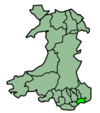Newport railway station
Newport railway station (Welsh: Gorsaf Rheilffordd Casnewydd) is the third-busiest railway station in Wales (after Cardiff Central and Cardiff Queen Street), situated in Newport city centre. It is 133.5 miles (215 km) from London Paddington on the British railway network.
| Newport | |
|---|---|
| Welsh: Casnewydd | |
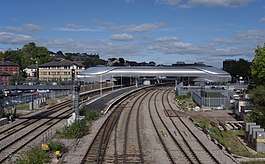 Newport railway station looking Eastbound. | |
| Location | |
| Place | Newport |
| Local authority | Newport |
| Coordinates | 51.5888°N 3.0004°W |
| Grid reference | ST 307 882 |
| Operations | |
| Station code | NWP |
| Managed by | Transport for Wales |
| Number of platforms | 4 |
| DfT category | B |
| Live arrivals/departures, station information and onward connections from National Rail Enquiries | |
| Annual rail passenger usage* | |
| 2014/15 | |
| – Interchange | |
| 2015/16 | |
| – Interchange | |
| 2016/17 | |
| – Interchange | |
| 2017/18 | |
| – Interchange | |
| 2018/19 | |
| – Interchange | |
| History | |
| 18 June 1850 | Opened |
| 1880 | Enlarged |
| 1928 | Enlarged |
| 2010 | Enlarged |
| National Rail – UK railway stations | |
| |
Gloucester–Newport line | ||||||||||||||||||||||||||||||||||||||||||||||||||||||||||||||||||||||||||||||||||||||||||||||||||||||||||||||||||||||||||||||||||||||||||||||||||||||||||||||||||||||||||||||||||||||||||||||||||||||||||||||||||||||||||||||||||||||||||||||||||||||||||||||||||||||||||||||||||||||||||||||||||||||||||||||||||||||||||||||||||||||||||||||||||
|---|---|---|---|---|---|---|---|---|---|---|---|---|---|---|---|---|---|---|---|---|---|---|---|---|---|---|---|---|---|---|---|---|---|---|---|---|---|---|---|---|---|---|---|---|---|---|---|---|---|---|---|---|---|---|---|---|---|---|---|---|---|---|---|---|---|---|---|---|---|---|---|---|---|---|---|---|---|---|---|---|---|---|---|---|---|---|---|---|---|---|---|---|---|---|---|---|---|---|---|---|---|---|---|---|---|---|---|---|---|---|---|---|---|---|---|---|---|---|---|---|---|---|---|---|---|---|---|---|---|---|---|---|---|---|---|---|---|---|---|---|---|---|---|---|---|---|---|---|---|---|---|---|---|---|---|---|---|---|---|---|---|---|---|---|---|---|---|---|---|---|---|---|---|---|---|---|---|---|---|---|---|---|---|---|---|---|---|---|---|---|---|---|---|---|---|---|---|---|---|---|---|---|---|---|---|---|---|---|---|---|---|---|---|---|---|---|---|---|---|---|---|---|---|---|---|---|---|---|---|---|---|---|---|---|---|---|---|---|---|---|---|---|---|---|---|---|---|---|---|---|---|---|---|---|---|---|---|---|---|---|---|---|---|---|---|---|---|---|---|---|---|---|---|---|---|---|---|---|---|---|---|---|---|---|---|---|---|---|---|---|---|---|---|---|---|---|---|---|---|---|---|---|---|---|---|---|---|---|---|---|---|---|---|---|---|---|---|---|---|---|---|---|---|---|---|---|---|---|---|---|---|---|---|---|---|---|---|---|
| ||||||||||||||||||||||||||||||||||||||||||||||||||||||||||||||||||||||||||||||||||||||||||||||||||||||||||||||||||||||||||||||||||||||||||||||||||||||||||||||||||||||||||||||||||||||||||||||||||||||||||||||||||||||||||||||||||||||||||||||||||||||||||||||||||||||||||||||||||||||||||||||||||||||||||||||||||||||||||||||||||||||||||||||||||
The station was originally opened in 1850 by the South Wales Railway Company and was greatly expanded in 1928. A new station building was built in 2010 with four full size platforms, to facilitate new Great Western Railway 10-car Intercity Express Programme trains.
The station is owned by Network Rail and managed by Transport for Wales.[1] The main station entrance is located on Queensway, connected by Station Approach to the High Street, with a further entrance adjoined to the National Car Parks site at its rear, reached from Devon Place.
Services
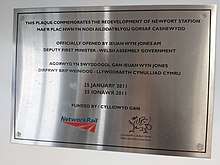
As at February 2019, the station is a calling point for GWR (who provide most of the services), as well as Transport for Wales and CrossCountry.
Transport for Wales

- 1 train per hour (tph) to Manchester Piccadilly via Hereford and Shrewsbury. These services are from Carmarthen, Milford Haven or Cardiff Central, operated by Class 175 Coradia units.[2]
- 1tph to Carmarthen with a two-hourly extension to Milford Haven via Cardiff Central, Bridgend, Port Talbot Parkway, Neath, Swansea, Llanelli and Pembrey and Burry Port. There is also one daily service to Tenby, departing Newport at 1640 and a daily service to Pembroke Dock, departing Newport at 1841. These services are from Manchester Piccadilly, operated by Class 175 Coradia units.
- 1tp2h to Holyhead via Hereford, Shrewsbury, Wrexham General, Chester, Llandudno Junction and Bangor. These services are from Cardiff Central, operated by Class 175 Coradia units and refurbished Class 158 Express Sprinter units.
- 1tp2h to Cardiff Central. These services are from Holyhead, operated by Class 175 Coradia units.
- 1tph to Cheltenham Spa via Severn Tunnel Junction and Gloucester. These services are usually from Maesteg but come from destinations such as Swansea and Fishguard, operated by Class 150 'Sprinter units, Class 158 Express Sprinter units and Class 175 Coradia units.[3]
- 1tph to Maesteg via Cardiff Central and Bridgend. These services originate from Cheltenham Spa but the 1700 service originates from Holyhead. These operated by Class 150 'Sprinter units, Class 158 Express Sprinter units and the daily service from Holyhead is operated by a Class 175 Coradia unit.
In October 2008 the Welsh Government announced the launch of a new faster services between Cardiff and North Wales. The service was first operated by Class 57 locomotives and Mark 2 passenger rolling stock. The Premier Service has premier business-class accommodation.[4] In March 2012 the service was upgraded to Class 67 locomotives and Mark 3 rolling stock.
CrossCountry
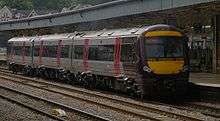
- 1tph to Nottingham via Gloucester, Cheltenham Spa, Birmingham New Street and Derby. These services are from Cardiff Central, operated by Class 170 Turbostar units.[5]
- 1tph to Cardiff Central. These services are usually from Nottingham or Birmingham New Street, operated by Class 170 Turbostar units, although there is one daily service at 20:49 from Manchester Piccadilly operated by a Class 221 SuperVoyager unit.
- 1tpd to Manchester Piccadilly via Bristol Temple Meads, Bristol Parkway, Cheltenham Spa, Birmingham New Street, Wolverhampton, Stoke-on-Trent, Macclesfield and Stockport, operated by a Class 221 SuperVoyager unit.
Great Western Railway
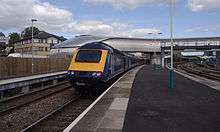

- 2tph to London Paddington via Bristol Parkway, Swindon, Didcot Parkway and Reading. These services are from Cardiff Central or Swansea as well as daily services from Carmarthen and Pembroke Dock, operated by Class 800s.
- 1tph to Swansea via Cardiff Central, Bridgend, Port Talbot Parkway, Neath and Swansea, as well as daily extensions to Carmarthen and Pembroke Dock. These services are from London Paddington, operated by Class 800s.[6]
- 1tph to Portsmouth Harbour via Bristol Temple Meads, Bath Spa, Westbury, Salisbury, Southampton Central, Fareham, Cosham, Fratton and Portsmouth & Southsea. These services are from Cardiff Central, operated by Class 166 Networker Turbo units[7]
- 1tph to Taunton via Bristol Temple Meads and Weston-super-Mare. These services are from Cardiff Central, operated by HST Castle Sets.[8]
- 2tpd on Sundays to Brighton via Bristol Temple Meads, Bath Spa, Westbury, Salisbury, Southampton Central, Fareham, Cosham, Fratton, Havant, Chichester, Barnham, Worthing, Shoreham-by-Sea and Hove. These services are from Cardiff Central, operated by Class 158 Express Sprinter units.
Ebbw Vale services
Phase Two of the Ebbw Valley Railway project would see the restoration of direct trains between Newport and Ebbw Vale and resurrect the suburban rail link with Rogerstone. In March 2008 following the success of phase one - direct services between Cardiff Central and Ebbw Vale - the Welsh Government's Minister for Economy and Transport launched a feasibility study into the restoration of direct trains from Newport. Significant works need to be carried out including the re-instatement of a set of points, refurbished track, new signals at the Gaer and Park junctions as well as track extensions between Crosskeys and Llanhilleth. The Welsh Government announced in July 2009 that the relevant works to enable direct trains between Ebbw Vale and Newport would be complete by 2011.[9]
After securing the Wales & Borders franchise in 2018, Transport for Wales announced that services will reopen between Newport and Ebbw Vale by 2021.[10]
| Preceding station | Following station | |||
|---|---|---|---|---|
| Cardiff Central | Transport for Wales Maesteg / Cardiff Central - Cheltenham Spa |
Severn Tunnel Junction | ||
| Transport for Wales Milford Haven/Carmarthen - Manchester Piccadilly |
Cwmbran | |||
| Transport for Wales Cardiff - Holyhead |
||||
| Cardiff Central | CrossCountry Cardiff Central - Nottingham |
Severn Tunnel Junction or Chepstow | ||
| CrossCountry Cardiff Central to Manchester Piccadilly via Bristol Temple Meads (Mondays to Saturdays only, limited service) |
Severn Tunnel Junction | |||
| Cardiff Central | Great Western Railway Cardiff Central / Swansea - London Paddington |
Bristol Parkway | ||
| Great Western Railway Cardiff Central - Taunton |
Severn Tunnel Junction | |||
| Great Western Railway Cardiff Central - Brighton / Portsmouth Harbour |
Filton Abbey Wood | |||
| Future services | ||||
| Pye Corner | Transport for Wales Ebbw Valley Railway |
Terminus | ||
History

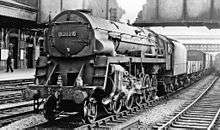
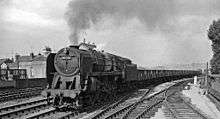
The current station layout consists of four through-platforms numbered 1 to 4 from the south side. The original broad gauge station had only two 200-foot-long (61 m) through platforms and a bay platform at the east end of the down platform. The Hillfield railway tunnels to the west of the station were dug under Stow Hill in the 1840s.[11] On the closure of Dock Street and Mill Street stations to passengers in 1880, High Street station was greatly expanded: The up platform was made into an island - the north face 825 feet (251 m) in length, and the south side 814 feet (248 m). The down platform was extended to 897 feet (273 m), with the west end bay extended to 428 feet (130 m). Two scissors crossovers were provided on these new platforms, effectively dividing them into two. The original down platform became Nos. 1 and 2. The bay became No. 3, the south face of the up platform Nos. 4 and 5 and the north face Nos. 6 and 7. The bay platform was mostly used for Monmouthshire western valleys services, but with the quadrupling of the line in 1912 trains from the bay platform (on the south side) now had to cross the entire station to get to the Gaer Tunnel on the north side. To address this the former loading dock on the north side of the station was made into a passenger platform (No. 8).
April 1961 saw the introduction of colour Multiple-Aspect Signalling and associated modifications to the station layout. The north face of the island platform became the new up platform, with the south face becoming the new down. The platforms were also renumbered in the opposite direction to match the new line designations — No. 8 became No. 1, Nos. 6/7 became 2, Nos. 4/5 became No. 5 and Nos. 1/2 became No. 6. Lines 3 and 4 became the designations for the through non-platform lines. Subsequent removal of the scissors crossovers saw a further combination and renumbering of platforms to the current layout.
Name
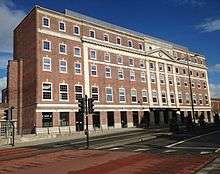
Originally named Newport High Street, the suffix High Street became unnecessary on the closure of Mill Street and Dock Street stations to goods traffic in the 1960s.[12] Printed tickets and National Rail enquiries use the suffix "South Wales" to differentiate this station from its namesake in Essex. In 2007 the Newport Unlimited urban regeneration company proposed the station be renamed Newport City railway station; however, this suggestion was not taken up.[13]
Accidents and incidents
Facilities
Platform 1 is only mainly used for westbound services to Cardiff Central during peak times. Platform 2 is usually the stopping point for all westbound services to Cardiff Central. Platform 3 is usually the stopping point for eastbound services to London Paddington and Nottingham. Platform 4 is usually the stopping point for eastbound services to Manchester Piccadilly, Holyhead, Portsmouth Harbour, Taunton and Cheltenham Spa and will also be used by trains to Ebbw Vale following the full re-opening of the Ebbw Valley Railway.
A British Transport Police station and a branch of WH Smith are situated on platform 1. The waiting room and customer toilets are situated between platforms 2 and 3, as is the Upper Crust café. Also between platforms 2 and 3 is a customer help desk. The booking hall is situated between the main entrance and platform 1. There are three main windows for tickets for immediate travel and a travel centre which handles enquiries, complaints and issues tickets for future travel. In the booking hall there is also a small buffet, telephones, automatic ticket machines and a photo booth. Wheelchair access between platforms is provided by a subway, accessed by a lift from the platforms. Also, a ramp from platforms 2 and 3 leads into a subway that links Mill Street to the city centre. There is a short-stay car park and taxi rank situated to the front and a long-stay car park to the rear which is accessible via a footbridge from all platforms. Since October 2005, automatic ticket barriers have been installed. At the same time, the ticket barriers are being used more often, before used during peak periods and match days, now manned throughout the day until late in the evening.
2007 development
The Welsh Government and Network Rail agreed a £20 million makeover for the station that provided two new concourses, a second pedestrian bridge over the tracks and a user-friendly bus-rail interchange at the station. The plans also included an extended platform 4 capable of accommodating up to twelve-carriage intercity trains and a new multi-storey car park for long-stay travellers. The initial redevelopment of Platform 4 did not allow for disabled access, resulting in station staff using a locally contracted taxi firm at £3 a passenger to move disabled and elderly passengers the half-mile from one side of the station to the other, in a complimentary service provision.[15] The first phase, platform 4 extension, was completed on 2 July 2007, with design works completed by Atkins.[16]
2009 development

_-_geograph.org.uk_-_1640291.jpg)
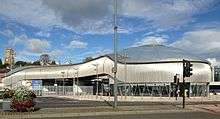
Planned to enable the station to cope with passenger traffic associated with the 2010 Ryder Cup, a second passenger bridge was built linking the whole station with a lift for all platforms. Network Rail claimed accessibility and safety are at the heart of the new design.
The new bridge is clad in ethylene tetrafluoroethylene (ETFE),[17] the material which protects the Eden Project in Cornwall. The station enhancements were engineered by Atkins Engineers, based in Exeter and Swindon, with design support from Grimshaw Architects and Vector Foiltec working as sub-consultants.[18] The new north and south concourses opened on 13 September 2010.[19]
The development was criticised by RAIL magazine columnist Barry Doe for being at the wrong end of the station, a lack of seating and generally poor design.[20] The station was nominated in 2011 for the Carbuncle Cup, awarded for the ugliest building of the year.[21]
Arriva Trains Wales had expressed concern about a leaking roof, an inadequate customer service area and insufficient ticket gates.[17] Network Rail said the roof was fixed in mid-May 2011, but issues had resumed in 2013.[22] Transport for Wales acquired the management of the station in 2018 and are replacing station infrastructure across the network.[10]
Subsequent developments
The whole Newport area was re-signalled from 2009–12, providing speed improvements on the relief lines.
The Great Western Main Line from London to Cardiff was electrified as part of the Great Western Main Line electrification scheme.[23] As part of this the former footbridge was removed in 2017.[24] Following the introduction of Hitachi Rail British Rail Class 800/802 trains and the new timetable introduced on 15 December 2019, journey times between Newport and London Paddington were reduced to around 1 hour 30 minutes[25] The power from Bristol Parkway through Newport was switched on on 14 September 2019, with electric running extended to Newport from 15 December, and as far as Cardiff over the Christmas period.[25]
In September 2018, plans were submitted to Newport City Council for a new footbridge between Devon Place and Queensway, to replace the subway used since the closure of the previous footbridge.[26]
The South East Wales Transport Alliance (SEWTA) have proposed an additional service (one in every two hours) to Abergavenny with a re-opened station in Caerleon, two trains per hour between Cwmbran and Abergavenny, and an hourly service to Pontypool and New Inn, subject to line enhancements in Abergavenny.
Transport for Wales have included some of these proposals in their plans for the later stages of their South Wales Metro scheme.[10]
See also
References
- https://www.nationalrail.co.uk/stations/NWP/details.html
- GB eNRT 2015-16 Edition, Table 131 (Network Rail)
- GB eNRT 2015-16 Edition, Table 128 (Network Rail)
- "SEWTA". SEWTA. Archived from the original on 7 February 2006. Retrieved 22 January 2013.
- GB eNRT 2015-16 Edition, Table 51 (Network Rail)
- GB eNRT 2015-16 Edition, Table 125 (Network Rail)
- GB eNRT 2015-16 Edition, Table 123 (Network Rail)
- GB eNRT 2015-16 Edition, Table 134 (Network Rail)
- "National Transport Plan" (PDF). Welsh Government. July 2009. p. 26. Archived from the original (PDF) on 6 August 2009. Retrieved 3 December 2017.
- "What's Happening in South East Wales | Transport for Wales". tfw.gov.wales. Retrieved 19 February 2019.
- "A Summary of the Early History of Newport". Bob Trett, newportpast.com. Retrieved 1 October 2007.
- Railway Magazine, July 1960
- "Newport Unlimited Minutes of the Meeting of the Board held on 22 November 2007". Newport Unlimited. 22 November 2007. Archived from the original on 21 November 2008. Retrieved 5 February 2008.
- Earnshaw, Alan (1991). Trains in Trouble: Vol. 7. Penryn: Atlantic Books. ISBN 0-906899-50-8.
- Taxis used between rail platforms BBC News - 17 August 2007
- "Newport Unlimited Annual Review 2005-06". Archived from the original on 7 February 2012. Retrieved 22 January 2013.
- Clark, Rhodri (July 2011). "Newport station roof leaks". Modern Railways. Ian Allan Publishing. p. 12.
- "Station revamp ahead of Ryder Cup". BBC News. 27 July 2009. Retrieved 27 July 2009.
- "Lasting benefits from £22m newport station upgrade". Retrieved 16 September 2010.
- Doe, Barry (4 May 2011). "The Fare Dealer". RAIL. Bauer Media (668): 51.
- "Carbuncle Cup 2011: MediaCity UK is crowned Britain's ugliest building". The Guardian. 1 September 2011. Retrieved 16 December 2018.
- "Newport £22m railway station futuristic roof 'leaking'". BBC News. 26 April 2013.
- "Great Western electrification and IEP to go ahead". Railnews.co.uk. 1 March 2011. Retrieved 22 January 2013.
- Newport railway station footbridge set to be removed South Wales Argus 18 March 2017
- "South Wales electrification". Network Rail. Retrieved 19 February 2019.
- "Plans for 'attractive' footbridge to replace city subway move step closer". South Wales Argus. 12 September 2018.
- South Wales Main Line - Newport ISBN 1-874103-76-3
External links
| Wikimedia Commons has media related to Newport railway station. |
- Newport (South Wales) station, Transport for Wales
- Newport Station (TFW) car park, National Car Parks
